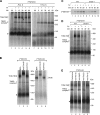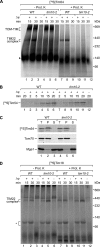The assembly pathway of the mitochondrial carrier translocase involves four preprotein translocases
- PMID: 18458057
- PMCID: PMC2447139
- DOI: 10.1128/MCB.02216-07
The assembly pathway of the mitochondrial carrier translocase involves four preprotein translocases
Abstract
The mitochondrial inner membrane contains preprotein translocases that mediate insertion of hydrophobic proteins. Little is known about how the individual components of these inner membrane preprotein translocases combine to form multisubunit complexes. We have analyzed the assembly pathway of the three membrane-integral subunits Tim18, Tim22, and Tim54 of the twin-pore carrier translocase. Tim54 displayed the most complex pathway involving four preprotein translocases. The precursor is translocated across the intermembrane space in a supercomplex of outer and inner membrane translocases. The TIM10 complex, which translocates the precursor of Tim22 through the intermembrane space, functions in a new posttranslocational manner: in case of Tim54, it is required for the integration of Tim54 into the carrier translocase. Tim18, the function of which has been unknown so far, stimulates integration of Tim54 into the carrier translocase. We show that the carrier translocase is built via a modular process and that each subunit follows a different assembly route. Membrane insertion and assembly into the oligomeric complex are uncoupled for each precursor protein. We propose that the mitochondrial assembly machinery has adapted to the needs of each membrane-integral subunit and that the uncoupling of translocation and oligomerization is an important principle to ensure continuous import and assembly of protein complexes in a highly active membrane.
Figures





Similar articles
-
Assembly of the three small Tim proteins precedes docking to the mitochondrial carrier translocase.EMBO Rep. 2008 Jun;9(6):548-54. doi: 10.1038/embor.2008.49. Epub 2008 Apr 18. EMBO Rep. 2008. PMID: 18421298 Free PMC article.
-
Mitochondrial import of the ADP/ATP carrier: the essential TIM complex of the intermembrane space is required for precursor release from the TOM complex.Mol Cell Biol. 2002 Nov;22(22):7780-9. doi: 10.1128/MCB.22.22.7780-7789.2002. Mol Cell Biol. 2002. PMID: 12391147 Free PMC article.
-
A cryptic matrix targeting signal of the yeast ADP/ATP carrier normally inserted by the TIM22 complex is recognized by the TIM23 machinery.Biochem J. 2005 Jan 1;385(Pt 1):173-80. doi: 10.1042/BJ20040650. Biochem J. 2005. PMID: 15320873 Free PMC article.
-
The preprotein translocase of the mitochondrial inner membrane: function and evolution.J Mol Biol. 1999 Feb 12;286(1):105-20. doi: 10.1006/jmbi.1998.2455. J Mol Biol. 1999. PMID: 9931253 Review.
-
Coupling of import and assembly pathways in mitochondrial protein biogenesis.Biol Chem. 2019 Dec 18;401(1):117-129. doi: 10.1515/hsz-2019-0310. Biol Chem. 2019. PMID: 31513529 Review.
Cited by
-
Protein trafficking in the mitochondrial intermembrane space: mechanisms and links to human disease.Biochem J. 2017 Jul 12;474(15):2533-2545. doi: 10.1042/BCJ20160627. Biochem J. 2017. PMID: 28701417 Free PMC article. Review.
-
Mitochondrial protein import clogging as a mechanism of disease.Elife. 2023 May 2;12:e84330. doi: 10.7554/eLife.84330. Elife. 2023. PMID: 37129366 Free PMC article.
-
Mitochondrial protein import: Mia40 facilitates Tim22 translocation into the inner membrane of mitochondria.Mol Biol Cell. 2013 Mar;24(5):543-54. doi: 10.1091/mbc.E12-09-0649. Epub 2013 Jan 2. Mol Biol Cell. 2013. PMID: 23283984 Free PMC article.
-
The Journey of Mitochondrial Protein Import and the Roadmap to Follow.Int J Mol Sci. 2023 Jan 27;24(3):2479. doi: 10.3390/ijms24032479. Int J Mol Sci. 2023. PMID: 36768800 Free PMC article. Review.
-
How lipids modulate mitochondrial protein import.J Bioenerg Biomembr. 2016 Apr;48(2):125-35. doi: 10.1007/s10863-015-9599-7. J Bioenerg Biomembr. 2016. PMID: 25690873 Review.
References
-
- Chacinska, A., M. Lind, A. E. Frazier, J. Dudek, C. Meisinger, A. Geissler, A. Sickmann, H. E. Meyer, K. N. Truscott, N. Pfanner, and P. Rehling. 2005. Mitochondrial presequence translocase: switching between TOM tethering and motor recruitment involves Tim21 and Tim17. Cell 120817-829. - PubMed
-
- Dekker, P. J. T., F. Martin, A. C. Maarse, U. Bömer, H. Müller, B. Guiard, M. Meijer, J. Rassow, and N. Pfanner. 1997. The Tim core complex defines the number of mitochondrial translocation contact sites and can hold arrested preproteins in the absence of matrix Hsp70-Tim44. EMBO J. 165408-5419. - PMC - PubMed
-
- Dekker, P. J. T., H. Müller, J. Rassow, and N. Pfanner. 1996. Characterization of the preprotein translocase of the outer mitochondrial membrane by blue native electrophoresis. Biol. Chem. 377535-538. - PubMed
Publication types
MeSH terms
Substances
LinkOut - more resources
Full Text Sources
Molecular Biology Databases
